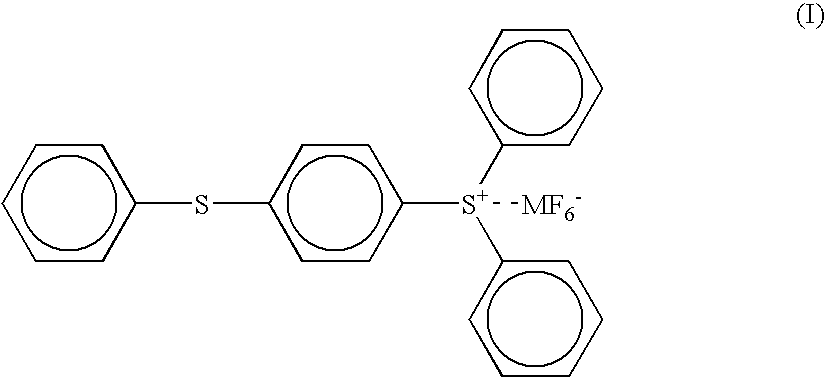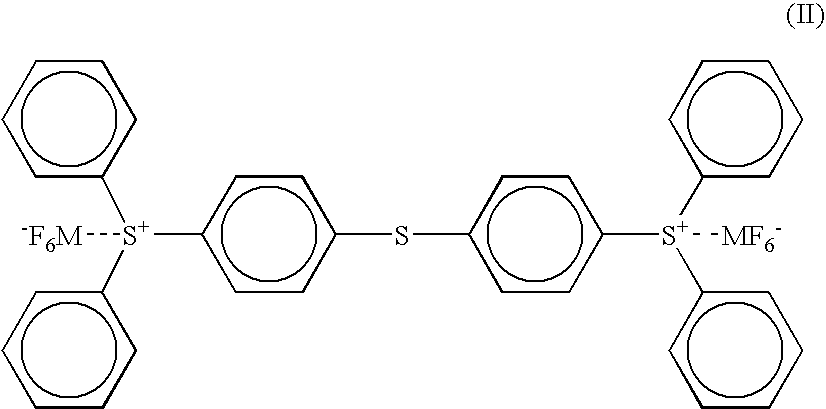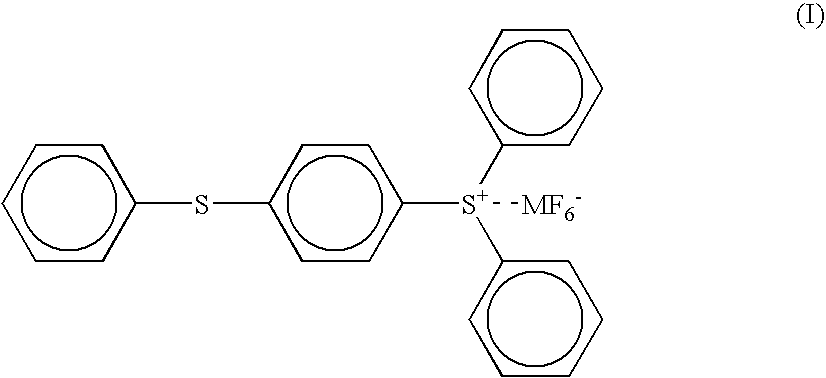Actinic radiation-curable stereolithographic resin composition having improved stability
a technology of stereolithography and resin composition, which is applied in the field of actinic radiationcurable resin composition for stereolithography, can solve the problems of insufficient the composition of photocurable resin containing a cationic-polymerizable organic compound such as an epoxy compound, and the time it takes to be molded, etc., to achieve the effect of improving storage stability and aging stability, and increasing viscosity
- Summary
- Abstract
- Description
- Claims
- Application Information
AI Technical Summary
Benefits of technology
Problems solved by technology
Method used
Image
Examples
production example 1
[0113] (1) Into a 100 ml reactor were supplied 5.86 g (21.3 mmol) of potassium hexafluoroantimonate and 10 ml of acetonitrile. After mixing with stirring, 2.13 g (21.3 mmol) of conc. sulfuric acid was added thereto followed by stirring for 30 minutes.
[0114] To the obtained solution, a solution containing 4.05 g (20.0 mmol) of diphenyl sulfoxide and 5.94 g (58.2 mmol) of acetonitrile anhydride having been homogeneously dissolved homogeneously was added at room temperature. Next, 3.61 g (19.4 mmol) of diphenyl sulfide was dropped thereinto and the obtained mixture was stirred at 40° C. for 2 hours. After cooling this liquid reaction mixture to room temperature, 20 ml of dichloromethane and 20 ml of water were added and dissolved followed by washing and separation. The organic layer was further washed thrice with 10 ml portions of water. Then dichloromethane and acetonitrile were distilled off to give 11.3 g of a somewhat yellowish solid product (yield: 96%).
[0115] (2) The solid prod...
example 1
[0118] (1) 1,500 parts of 3,4-epoxycyclohexylmethyl-3,4-epoxycyclohexane carboxylate, 500 parts of bisphenol A bis(propylene glycol glycidyl ether) ether (“RIKA RESIN BPO-20E” manufactured by New Japan Chemical Co., Ltd.) 500 parts of 2,2-bis(4-(acryloxydiethoxy)phenyl)propane (“NK ESTER A-BPE-4” manufactured by Shin-Nakamura Chemical Co., Ltd.), 400 parts of propylene oxide-denatured trimethylolpropane triacrylate (“ATM-4P” manufactured by Shin-Nakamura Chemical Co., Ltd.), 300 parts of dicyclopentadienyl diacrylate (“A-DCP” manufactured by Shin-Nakamura Chemical Co., Ltd.) and 300 parts of 3-methyl-3-hydroxymethyloxetane were mixed together and stirred at 20 to 25° C. for about 1 hour to prepare a mixture containing a cationic-polymerizable organic compound, a radical-polymerizable organic compound and an oxetane monoalcohol (total mass of the mixture: 3,500 parts).
[0119] (2) 100 parts of the (4-thiophenyl)diphenylsulfonium hexafluoroantimonate (the compound of the above formula ...
example 2
[0129] (1) 1,800 parts of 3,4-epoxycyclohexylmethyl-3,4-epoxycyclohexane carboxylate, 500 parts of bisphenol 2,2-bis(4-(acryloxydiethoxy)-phenyl)propane (“NK ESTER A-BPE-4” manufactured by Shin-Nakamura Chemical Co., Ltd.; having 4 mol of ethylene oxide unit added), 300 parts of propylene oxide-denatured pentaerythritol tetraacrylate (“ATM-4P” manufactured by Shin-Nakamura Chemical Co., Ltd.), 300 parts of 3-methyl-3-hydroxymethyloxetane and 300 parts of polytetramethylene glycol (number-average molecular weight: 2,000) were mixed together and stirred at 20 to 25° C. for about 1 hour to prepare a mixture (total mass of the mixture: 3,200 parts).
[0130] (2) 100 parts of the (4-thiophenyl)diphenylsulfonium hexafluoroantimonate (the compound of the above formula (I) wherein M is an antimony atom) having a purity of 98% as obtained in the PRODUCTION EXAMPLE 1 was dissolved in 100 parts of propylene carbonate to give a solution for a photo cationic polymerization initiator.
[0131] (3) Un...
PUM
| Property | Measurement | Unit |
|---|---|---|
| wavelength | aaaaa | aaaaa |
| temperature | aaaaa | aaaaa |
| viscosity | aaaaa | aaaaa |
Abstract
Description
Claims
Application Information
 Login to View More
Login to View More - R&D
- Intellectual Property
- Life Sciences
- Materials
- Tech Scout
- Unparalleled Data Quality
- Higher Quality Content
- 60% Fewer Hallucinations
Browse by: Latest US Patents, China's latest patents, Technical Efficacy Thesaurus, Application Domain, Technology Topic, Popular Technical Reports.
© 2025 PatSnap. All rights reserved.Legal|Privacy policy|Modern Slavery Act Transparency Statement|Sitemap|About US| Contact US: help@patsnap.com



